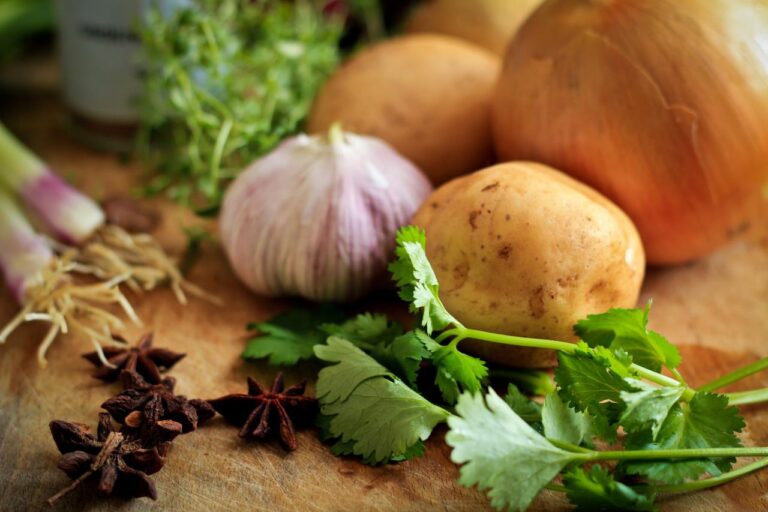How do you prevent food poisoning?
Did you know that an estimated 1 in 6 Americans will get sick from food poisoning this year alone? Food poisoning not only sends 128,000 Americans to the hospital each year—it can also cause long-term health problems. You can help keep your family safe from food poisoning at home by following these four simple steps: clean, separate, cook and, chill.
Clean: Wash Hands, Utensils, and Surfaces Often
Germs that can make you sick can survive in many places around your kitchen, including your food, hands, utensils, cutting boards, and countertops.
Wash your hands the right way:
- Use plain soap and water—skip the antibacterial soap—and scrub the backs of your hands, between your fingers, and under your nails for at least 20 seconds. Need a timer? Hum the “Happy Birthday” song from beginning to end twice.
- Rinse hands, then dry with a clean towel.
- Wash your hands often, especially during these key times when germs can spread:
- Before, during, and after preparing food
- After handling raw meat, poultry, seafood, or their juices, or uncooked eggs
- Before eating
- After using the toilet
- After changing diapers or cleaning up a child who has used the toilet
- After touching an animal, animal feed, or animal waste
- After touching garbage
- Before and after caring for someone who is sick
- Before and after treating a cut or wound
- After blowing your nose, coughing, or sneezing
- After handling pet food or pet treats.
Wash surfaces and utensils after each use:
- Wash cutting boards, dishes, utensils, and countertops with hot, soapy water, especially after they’ve held raw meat, poultry, seafood, or eggs.
- Wash dish cloths often in the hot cycle of your washing machine.
Wash fruits and vegetables, but not meat, poultry, or eggs:
- Rinse fruits and vegetables under running water without soap, bleach, or commercial produce washes.
- Rinse fruits and vegetables before peeling, removing skin, or cutting away any damaged or bruised areas.
- Scrub firm produce like melons or cucumbers with a clean produce brush.
- Dry produce with a paper towel or clean cloth towel.
- Don’t wash meat, poultry, eggs, or seafood to avoid spreading harmful germs around your kitchen.
- Produce labeled as “pre-washed” does not need to be washed again.
Separate: Don’t Cross Contaminate
Use separate cutting boards and plates for produce, meat, poultry, seafood, and eggs:
- Use one cutting board for fresh produce or other foods that won’t be cooked before they’re eaten, and another for raw meat, poultry, or seafood. Replace them when they are worn.
- Use separate plates and utensils for cooked and raw foods.
- Use hot, soapy water to thoroughly wash plates, utensils, and cutting boards that touched raw meat, poultry, seafood, eggs, or flour.
Keep certain types of food separate:
- In your shopping cart, separate raw meat, poultry, seafood, and eggs from other foods and place packages of raw meat, poultry, and seafood in plastic bags if available. When you check out, place raw meat, poultry, and seafood in separate bags from other foods.
- At home, place raw meat, poultry, and seafood in containers or sealed, leakproof plastic bags. Freeze them if you’re not planning to use them within a few days.
- In the fridge, keep eggs in their original carton and store them in the main compartment—not in the door.
Cook to the Right Temperature
Food is safely cooked when the internal temperature is high enough to kill germs that can make you sick:
- Use a food thermometer to be sure your food is safe. When you think your food is done, place the food thermometer in the thickest part of the food, making sure not to touch bone, fat, or gristle.
- Refer to our Minimum Cooking Temperatures Chart to be sure your foods have reached a safe temperature.
Keep food hot (140°F (60°C) or above) after cooking:
If you’re not serving food right after cooking, keep it out of the temperature danger zone (between 40°F (4°C) – 140°F (60°C)) where germs grow rapidly by using a heat source like a chafing dish, warming tray, or slow cooker.
Microwave food thoroughly (165°F (74°C) or above):
- Read package directions for cooking and follow them exactly to make sure food is thoroughly cooked.
- If the food label says, “Let stand for x minutes after cooking,” follow the directions — letting microwaved food sit for a few minutes allows food to cook thoroughly as colder areas absorb heat from hotter areas.
- Stir food in the middle of heating. Follow package directions for commercially prepared frozen food; some are not designed to be stirred while heating.
Chill: Refrigerate and Freeze Food Properly
Refrigerate perishable foods within 2 hours:
- Bacteria that cause food poisoning multiply quickest between 40°F (4°C) and 140°F (60°C).
- Your refrigerator should be set to 40°F (4°C) or below and your freezer to 0°F (-18°C) or below. Use an appliance thermometer to be sure.
- Never leave perishable foods out of refrigeration for more than 2 hours. If the food is exposed to temperatures above 90°F (32°C) (like a hot car or summer picnic), refrigerate it within 1 hour.
- Leftovers should be placed in shallow containers and refrigerated promptly to allow quick cooling.
- Never thaw or marinate foods on the counter. The safest way to thaw or marinate meat, poultry, and seafood is in the refrigerator.
- Freezing does not destroy harmful germs, but it does keep food safe until you can cook it.
- Know when to throw out food by checking our Safe Storage Times chart. Be sure you throw food out before harmful bacteria grow.
Source:foodsafety
